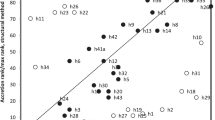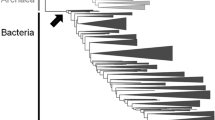Abstract
We carried out a comprehensive survey of small subunit ribosomal RNA sequences from archaeal, bacterial, and eukaryotic lineages in order to understand the general patterns of thermal adaptation in the rRNA genes. Within each lineage, we compared sequences from mesophilic, moderately thermophilic, and hyperthermophilic species. We carried out a more detailed study of the archaea, because of the wide range of growth temperatures within this group. Our results confirmed that there is a clear correlation between the GC content of the paired stem regions of the 16S rRNA genes and the optimal growth temperature, and we show that this correlation cannot be explained simply by phylogenetic relatedness among the thermophilic archaeal species. In addition, we found a significant, positive relationship between rRNA stem length and growth temperature. These correlations are found in both bacterial and archaeal rRNA genes. Finally, we compared rRNA sequences from warm-blooded and cold-blooded vertebrates. We found that, while rRNA sequences from the warm-blooded vertebrates have a higher overall GC content than those from the cold-blooded vertebrates, this difference is not concentrated in the paired regions of the molecule, suggesting that thermal adaptation is not the cause of the nucleotide differences between the vertebrate lineages.


Similar content being viewed by others
References
Bernardi G (2000) The compositional evolution of vertebrate genomes. Gene 259:31–43
Brochier C, Forterre P, Gribaldo S (2004) Archaeal phylogeny based on proteins of the transcription and translation machineries:tackling the Methanopyrus kandleri paradox. Genome Biol 5(3):R17
Dalgaard JZ, Garrett RA. (1993) Archaeal hyperthermophile genes. In: Kates M, Kushner DJ, Matheson AT (eds) The biochemistry of Archaea (Archaebacteria). Elsevier, Amsterdam, pp 535–563
Felsenstein J (1985) Phylogeny and the comparative method. Am Nat 125:1–15
Foster PG, Hickey DA (1999) Compositional bias may affect both DNA-based and protein-based phylogenetic reconstructions. J Mol Evol 48:284–290
Galagan JE, Nusbaum C, Roy A, et al. (2002) The genome of M. acetivorans reveals extensive metabolic and physiological diversity. Genome Res 12:532–542
Galtier N, Lobry JR (1997) Relationships between genomic GC content, RNA secondary structures and optimal growth temperature in prokaryotes. J Mol Evol 44:632–636
Gutell RR, Cannone JJ, Shang Z, Du Y, Serra MJ. (2000) A story: unpaired adenosine bases in ribosomal RNAs. J Mol Biol 304:335–354
Harvey PH, Pagel MD (1991) The comparative method in evolutionary biology. Oxford University Press, Oxford
Hasegawa M, Hashimoto T (1993) Ribosomal RNA trees misleading? Nature 361:23
Hurst LD, Merchant AR. (2001) High guanine-cytosine content is not an adaptation to high temperature: a comparative analysis amongst prokaryotes. Proc R Soc Lond B 268:493–497
Nakashima H, Fukuchi S, Nishikawa K (2003) Compositional changes in RNA, DNA and proteins for bacterial adaptation to higher and lower temperatures. J Biochem 133:507–513
Singer GAC, Hickey DA. (2003) Thermophilic prokaryotes have characteristic patterns of codon usage, amino acid composition and nucleotide content. Gene 317:39–47
Van de Peer Y, De Rijk P, Wuyts J, Winkelmans T, De Wachter R. (2000) The European small subunit ribosomal RNA database. Nucleic Acids Res. 28:175–176
Wang H-C (2005) The effects of nucleotide bias on genome evolution. PhD thesis. University of Ottawa, Ottawa
Wang H-C, Hickey DA (2002) Evidence for strong selective constraint acting on the nucleotide composition of 16S ribosomal RNA genes. Nucleic Acids Res 30:2501–2507
Wuyts J, Van de Peer Y, Winkelmans T, De Wachter R. (2002) The European database on small subunit ribosomal RNA. Nucleic Acids Res 30:183–185
Acknowledgments
This work was supported by a Research Grant from NSERC Canada (D.A.H.) and an Ontario Graduate Scholarship (H.C.W.). We thank Dr. N. Galtier and two reviewers for their comments.
Author information
Authors and Affiliations
Corresponding author
Additional information
[Reviewing Editor: Dr. Nicolas Galtier]
Electronic Supplementary Material
Rights and permissions
About this article
Cite this article
Wang, HC., Xia, X. & Hickey, D. Thermal Adaptation of the Small Subunit Ribosomal RNA Gene: A Comparative Study. J Mol Evol 63, 120–126 (2006). https://doi.org/10.1007/s00239-005-0255-4
Received:
Accepted:
Published:
Issue Date:
DOI: https://doi.org/10.1007/s00239-005-0255-4




